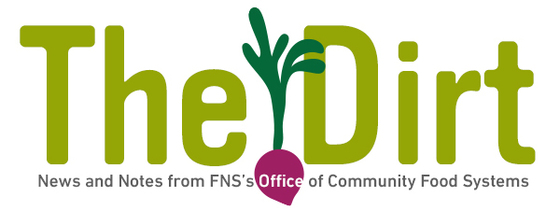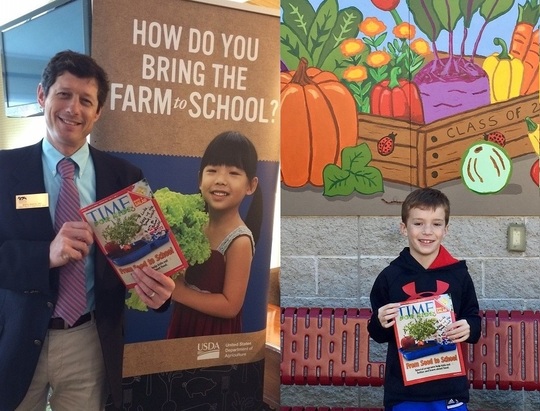
Celebrate Native American Heritage Month with School Meals
In celebration of
Native American Heritage Month this November, we bring you this inspiring story from Monterey Peninsula Unified School District (MPUSD). Story from Jenifer Gerard.
In past school years, MPUSD prepared monthly
theme meals to honor and celebrate cultures recognizing food as a central aspect of
history, heritage, and development. Here
is an excerpt from the handout the district distributed to teachers and parents, asking
them to help celebrate Native American Day, a California state holiday:
Native Americans in California enjoyed a mild climate
which meant they could rely year-round on the abundant food supplies of
their natural surroundings. Nuts, berries, cacti, and animals made up a basis
of the diet, which was supplemented lightly by agriculture and hunting meat
when available.
The three staples
in the Native American diet were corn, squash and beans. These
were called the "Three Sisters" because they were planted interdependently:
the beans grew up the tall stalks of the maize, while the squash spread out at
the base of the three plants and provided protection and support for the root
systems.
Check out MPUSD's Native American Day lunch menu:
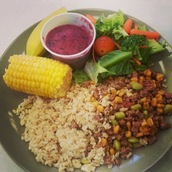
Succotash:
Succotash
originated among the Native Americans of North America and is a dish primarily
of shell beans and corn. Native Americans
made Succotash and taught the colonists how to make it, which has led to a
variety of additional flavors and ingredients. Our version consists of corn, tomatoes,
beans, ground beef, salt, pepper and nutmeg and will be served with a side of
brown rice.
Corn on the
Cob: Eaten at many meals, corn was one of the Native American’s main
foods. They would eat it boiled, dried and cracked as hominy and would
also ground corn into corn meal for a variety of uses. The husks from the
corn cob were also used: braided and used for sleeping mats, baskets, dolls or
even shoes! Corn came in a variety of colors, such as white, red, blue and
yellow.
Fresh
Berries: Growing wild across many parts of America, blackberries,
strawberries, blueberries, and raspberries played a part in many native diets.
We will be serving a mix of fresh blueberries, blackberries & strawberries.
Akutaq (Eskimo ice
cream):
The native people of Alaska have a distinct version of ice cream. It's not
creamy ice cream as we know it, but a concoction made from caribou
fat, seal oil, freshly fallen snow or water, fresh berries, and
sometimes ground fish! Traditionally it was made for funerals,
celebrations of a boy's first hunt, or almost any other community
event. It is eaten as a dessert, a meal, a snack, or a spread. Our
version is simply frozen berries whipped with yogurt as we are
currently out of seal oil!
|
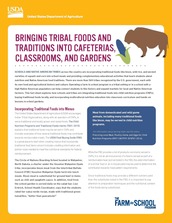 Inspired by MPUSD? Check out these resources to learn more about traditional foods in child nutrition programs:
|

FoodCorps Can Help Bring the Farm to Summer
While summer may seem far off, now is actually the time that many state
agencies will gather program operators and community partners to plan for a
successful summer 2017. In many states, FoodCorps can help:
- Connect summer sponsors with sources of local food;
- Conduct activities like taste tests, demonstrations, and gardening at
meal sites; and,
- Help spread the word about summer meals and encourage participation
Find out more about how FoodCorps can
help build healthy Summer Meals Programs with this new fact
sheet!
|

Farm to School Pen Pals in the Northeast
Did
your elementary school kids see the farm to school article in the September
issue of Time for Kids? Well, one
student in Massachusetts loved the article and the work that Burlington,
Vermont's school nutrition director, Doug Davis, is doing that he asked USDA
Farm to School Regional Lead, Danielle Fleury, to get the issue autographed by
Doug Davis himself!
Luke Zamaloff was reading Time for Kids in
his 2nd grade class at Collicot Elementary School in Milton Public Schools, when the words “farm
to school” jumped off the page. He recognized the phrase and circled them with
his pencil. In the article, Doug Davis of the Burlington School Food Project
talks about how students in Burlington learn about the food that they eat in
the cafeteria by tending school gardens. While in a different state and
quite a different setting, this all sounded very familiar to Luke, who sees a
garden next to his playground and spends time in his “outdoor classroom”,
planting, maintaining, and learning. From metro Boston to Vermont,
farm to school connects students, school nutrition staff, teachers, parents,
and community members around a common vision.
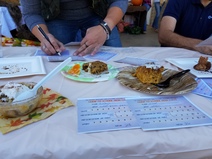
By Rachel Spencer, Farm to School Regional Lead, Food and Nutrition Service, Southwest Regional Office
On October 22, the newest celebrity chefs of Alexandria, La. gathered at the Inglewood Farm’s Harvest Barn Market to celebrate National Farm to School Month. Their purpose: emerge victorious from the Farm to School Iron Chef Competition.
This competition challenged contestants to create a dish using a
“secret ingredient,” in this case sweet potatoes – a fall favorite and
regional staple. Each of the four teams sourced sweet potatoes from
local farmers in central Louisiana. Students worked alongside parents
and teachers to prepare and present their dishes at the market on the
day of the competition. The event was organized by the Central Louisiana Economic Development Alliance (CLEDA).
Consisting of economic development entities from ten parishes across
Louisiana, CLEDA’s mission is to help people prosper in vibrant,
thriving communities.
|

|




